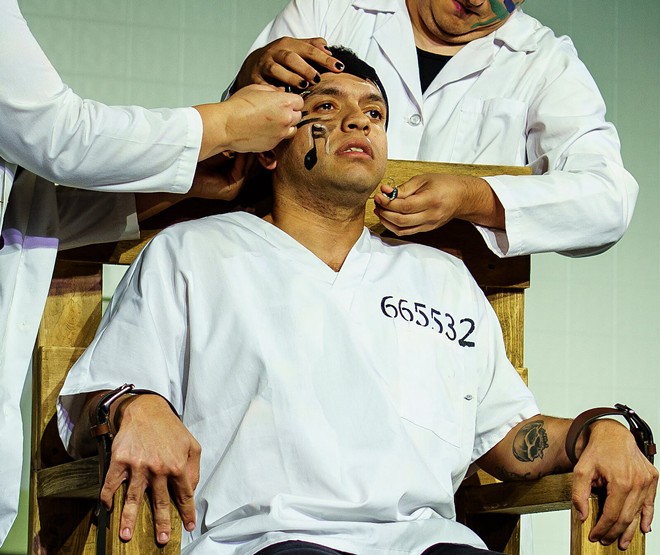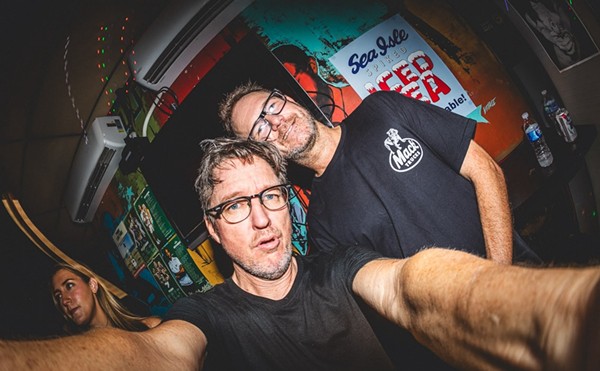
A projection on Brian Smallheer’s white tile asylum set tells Tampa theatergoers they’ve been transported to the “capital city” in the “near future” of what turns out to be a dismal dystopian England. It’s a darkly comic modern tale of a totalitarian society where violent youths abound. Alex (the charismatic Donovan Whitney) has a passion for classical music and is a member of a vicious, anarchic teen gang of droogs (friends) indulging in orgies fueled by narcotic-spiked milk and gleefully committing random acts of utterly sickening brutality against defenseless citizens. After being caught and imprisoned, Alex opts to undergo state-sponsored psychological “aversion therapy” rehabilitation to reduce his sentence. Burgess’s savage 1962 satire was prophetic, anticipating the hedonistic ‘60s yielding to ‘70s disillusionment.
For this intermission-less 85-minute production, Director Dan Granke notes, that the “characters are broad, mostly nameless representations of the state or various ideological state apparatus (the church, the scientific establishment, the elderly, etc.)” This is workable in theory, but underwhelming in practice. The performance style in the intimate Shimberg Playhouse is so broad that it lacks real menace. Despite Brecht’s urging against audience empathy, playgoers inevitably identify with the action. If everything is dramatic, nothing is important.
Jobsite’s design team, however, really delivers. Jeremy Douglass provides evocative sound, costumer Katrina Stevenson outfits the ensemble’s many roles distinctly, especially the droogs in colorful leather and circus war paint. The MVP, however, is Jo Averill-Snell who has been given a blank canvas of a set, which she paints with every imaginable color and texture to suit the locations and dystopian mood swings.

The larger issue is how can a play ever shock us with hand combat implements that may have been fearful in 1962, but are timid, even ho hum, in a culture half a century later when Congress lacks the courage even to ban weapons of war after Sandy Hook with the massacre of 27 kindergartners? And now, when nearly a decade has passed since that awful day in 2012, the daily news is filled with shocking images of war in Ukraine and Putin threatens a nuclear option? Burgess’ droogs have zero impact.
The ethical dilemma for us to ponder is redemption and free will. Does being forced to be good deprive us of humanity? How can we truly be good, unless we have the free choice to be (or actively reject) evil. While Alex and his gang of teenage thugs go through ugly motions, there’s never a real sense of fear, danger, or revulsion for modern crowds. Our culture is so desensitized I’m not even sure how to create an irredeemable monster at the outset, in order for the government ordered aversion therapy to seem justified. And then, of course, the cure has to be as frightening as the disease. Unless the action is genuinely horrific, the point doesn’t land with the dramatic force that the original material demands. Nothing about this very well-intentioned production makes the audience squirm. There are some unpleasant descriptions, but nothing visceral to shock us.

Kudos, though, to the ensemble which portrays dozens of roles: William Alejandro Barba, Jada Canty, Kiara Flowers, Amanda Heisey, Haley Janeda, Daniel Lennox, Jr., Brianna McVaugh, Omen Thomas Sade, and Jared Sellick.
Regardless of my Brechtian failure, producer David Jenkin’s hope “to spark conversations” about free will, mind control and the nature of violence is as inevitable as the sunrise.















